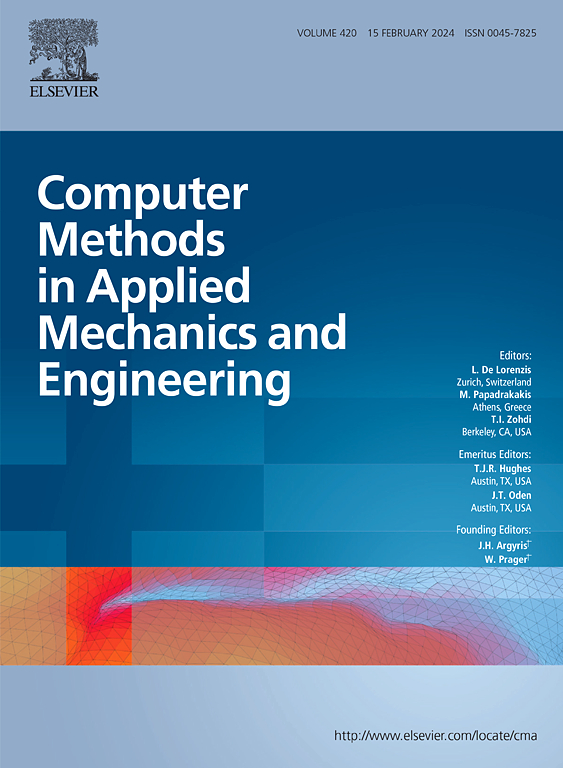Neural networks meet phase-field: A hybrid fracture model
IF 6.9
1区 工程技术
Q1 ENGINEERING, MULTIDISCIPLINARY
Computer Methods in Applied Mechanics and Engineering
Pub Date : 2025-03-30
DOI:10.1016/j.cma.2025.117937
引用次数: 0
Abstract
We present a hybrid phase-field model of fracture at finite deformation and its application to quasi-incompressible, hyperelastic rubber. The key idea is to combine the predictive capability of the well-established phase-field approach to fracture with a physics-augmented neural network (PANN) that serves as a flexible, high-fidelity model of the response of the bulk material. To this end, recently developed neural network approaches are developed further to better meet specific requirements of the phase-field framework. In particular, a novel architecture for a hyperelastic PANN is presented, that enables a decoupled description of the volumetric and the isochoric response based on a corresponding additive decomposition of the Helmholtz free energy. This is of particular interest when modelling fracture of soft quasi-incompressible solids with the phase-field approach, where a weakening of the incompressibility constraint in fracturing material is required. In addition, such an additive decomposition of the free energy is a prerequisite for the application of several split methods, i.e. decompositions of free energy into degraded and non-degraded portions, which can improve model behaviour under multiaxial stress states. For the formulation of the hybrid model, we define a pseudo-potential, in which the phase-field ansatz for fracture dissipation is combined with a polyconvex PANN model of the isochoric response. The PANN is formulated in polyconvex isochoric invariants. As a result, it can be shown that the PANN fulfils all desirable properties of hyperelastic potentials by construction. In particular, it is proven to be zero and take a global minimum for the undeformed state, which does also hold in case of deviations away from incompressibility. Moreover, a classical mixed displacement-pressure formulation of incompressibility based on the perturbed Lagrangian approach is included. Thereby, a relaxation of the incompressibility constraint in fracturing material is applied. This weakening of incompressibility is shown in to be essential in order to prevent numerical issues in the simulation, which would otherwise arise from the presence of zones showing both negligible isochoric stiffness and very high resistance against volume changes. The model is implemented in the finite element framework FEniCSx and studied by means of several examples. To this end, training and validation of the PANN are performed based on experimental data from the literature, and the hybrid fracture model is then verified against results of fracture experiments.
求助全文
约1分钟内获得全文
求助全文
来源期刊
CiteScore
12.70
自引率
15.30%
发文量
719
审稿时长
44 days
期刊介绍:
Computer Methods in Applied Mechanics and Engineering stands as a cornerstone in the realm of computational science and engineering. With a history spanning over five decades, the journal has been a key platform for disseminating papers on advanced mathematical modeling and numerical solutions. Interdisciplinary in nature, these contributions encompass mechanics, mathematics, computer science, and various scientific disciplines. The journal welcomes a broad range of computational methods addressing the simulation, analysis, and design of complex physical problems, making it a vital resource for researchers in the field.

 求助内容:
求助内容: 应助结果提醒方式:
应助结果提醒方式:


